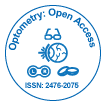Teleophthalmology: Expanding Access to Eye Care Through Technology
Received: 03-Mar-2025 / Manuscript No. omoa-25-170232 / Editor assigned: 05-Mar-2025 / PreQC No. omoa-25-170232 / Reviewed: 18-Mar-2025 / QC No. omoa-25-170232 / Revised: 23-Mar-2025 / Manuscript No. omoa-25-170232 / Published Date: 29-Mar-2025
Introduction
Teleophthalmology is a specialized branch of telemedicine that focuses on delivering eye care services remotely using telecommunications technology. It enables ophthalmologists and other eye care professionals to screen, diagnose, monitor, and even manage certain eye conditions without requiring patients to be physically present in a clinic. As global demand for eye care rises—especially in aging populations and underserved communities—teleophthalmology offers a promising solution to bridge gaps in access, reduce healthcare costs, and ensure timely interventions for preventable vision loss [1],[2].
Discussion
The core function of teleophthalmology is the remote exchange of medical information related to eye health. This can include high-resolution retinal images, patient history, visual acuity tests, and other diagnostic data, which are captured at one location and transmitted to a specialist at another for interpretation and treatment planning. Technologies used in teleophthalmology include fundus cameras, OCT (optical coherence tomography) devices, slit-lamp imaging, and mobile apps that allow for patient interaction and data transfer [3],[4].
One of the key benefits of teleophthalmology is its ability to reach patients in remote, rural, or underserved areas where access to ophthalmologists is limited. For example, patients in small communities can have retinal images taken by trained technicians at local clinics or even pharmacies, with results reviewed by a remote ophthalmologist. This approach is particularly useful for screening chronic conditions like diabetic retinopathy, glaucoma, and age-related macular degeneration—all of which require regular monitoring to prevent vision loss [5],[6].
In addition to expanding access, teleophthalmology can also reduce waiting times and healthcare costs. By triaging patients remotely, eye care providers can prioritize urgent cases for in-person visits while managing routine or follow-up care virtually. This optimizes resource allocation and reduces the burden on overbooked urban clinics and hospitals. Moreover, early detection through teleophthalmology often leads to better outcomes and lowers the long-term cost of treatment [7],[8].
The integration of artificial intelligence (AI) is further enhancing the capabilities of teleophthalmology. AI algorithms can analyze retinal images with high accuracy, flagging abnormalities and helping specialists make faster, data-driven decisions. This technology is especially beneficial in large-scale screening programs, where thousands of images may need to be processed efficiently [9],[10].
However, teleophthalmology does face some limitations. Certain complex eye conditions and procedures still require in-person examination and equipment. There are also challenges related to internet connectivity, availability of trained personnel, and data privacy concerns. Ensuring secure transmission of patient data and complying with health regulations is crucial for maintaining patient trust and system integrity.
Conclusion
Teleophthalmology is transforming the landscape of eye care by making specialized services more accessible, efficient, and patient-centered. While it cannot replace every aspect of traditional ophthalmology, it serves as a powerful tool in preventing vision loss and improving eye health, especially in populations that have historically faced barriers to care. With continued technological advancement and thoughtful implementation, teleophthalmology has the potential to become a standard component of comprehensive eye care worldwide.
References
- Ahn JM, Lee SY, Yoon JS (2010) Health-related quality of life and emotional status of an ophthalmic patient in Korea. Am J Ophthalmol 149: 1005- 1011.
- Moshfeghi DM, Moshfeghi AA, Finger PT (2000) Enucleation. Surv Ophthalmol 44: 277–301.
- Chaudhry IA, Alkuraya HS, Shamsi FA, Elzaridi E, Riley FC et al. (2007) Current indications and resultant complications of evisceration. Ophthalmic Epidemiol 14: 93–97.
- Rahman I, Cook AE, Leatherbarrow B (2005) Orbital exenteration: a 13 year Manchester experience. Br J Ophthalmol 89: 1335–1340.
- Custer PL, Reistad CE (2000) Enucleation of blind, painful eyes. Ophthalmic Plast Reconstr Surg 16: 326–329.
- Rasmussen ML, Prause JU, Johnson M, KamperJørgensen F, Toft TB, et al. (2010) Review of 345 eye amputations carried out in the period 1996–2003, at Rigshospitalet, Denmark. Acta Ophthalmologica 88: 218–221.
- Rose GE, Wright JE (1994) Exenteration for benign orbital disease. Br J Ophthalmol 78: 14–18.
- Rasmussen MLR (2010) The eye amputated-consequences of eye amputation with emphasis on clinical aspects, phantom eye syndrome and quality of life. Acta Ophthalmologica 88: 1–26.
- Shoamanesh A, Pang NK, Oestreicher JH (2007) Complications of orbital implants: a review of 542 patients who have undergone orbital implantation and 275 subsequent peg placements. Orbit 26: 173–182.
- Rasmussen MLR, Prause JU, Ocularist MJ, Toft PB (2009) Phantom eye syndrome: types of visual hallucinations and related phenomena. Ophthalmic Plast Reconstr Surg 25: 390–393.
Citation: Orhan P (2025) Teleophthalmology: Expanding Access to Eye Care Through Technology. Optom Open Access 10: 309.
Copyright: © 2025 Orhan P. This is an open-access article distributed under the terms of the Creative Commons Attribution License, which permits unrestricted use, distribution, and reproduction in any medium, provided the original author and source are credited.
Select your language of interest to view the total content in your interested language
Share This Article
Recommended Journals
Open Access Journals
Article Usage
- Total views: 266
- [From(publication date): 0-0 - Dec 15, 2025]
- Breakdown by view type
- HTML page views: 208
- PDF downloads: 58
